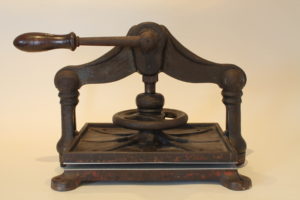
In 2011, I worked on a project at the Bodleian Library to conserve the Abinger collection: correspondence and papers of three generations of the Godwin and Shelley families that were given to the Library in 2004. Within this collection are 189 wet-transfer copies taken from the correspondence of novelist and political philosopher William Godwin. Godwin’s copies were taken over a ten-year period from 1795 to 1805 and were produced using James Watt’s copy press method.
Shortly after researching the Abinger papers and Watt’s copy press method of production, I acquired this little press. It’s quite small in size, the platen is only 275mm by 213mm and the daylight is only 43mm at its maximum. This confirms that it is a copy press rather than a bookbinding press. There are also remnants of red paint and gold decoration so it must have been quite a handsome object when new. There are no maker’s marks so it has proved difficult to find out more about the press but I believe it to be quite rare as I haven’t come across another with a combined handle and wheel mechanism. The previous owners were an English family with an American connection; as American presses tend to have wheels and European presses tend to have arms, it is possible that this press came from America.
The following is an exert from a paper I gave in Oxford in 2012 for AMARC (the Association of Manuscripts and Archives in research collections) which gives a brief account of James Watt’s invention:
In 1780 engineer James Watt patented the first method a taking a true copy of a manuscript. Before Watt’s invention experiments had been made with the use of multiple pens with various success. Watt’s idea was to take a direct impression from the ink of the original manuscript. He developed a process with three component parts:
- inks that would remain wet long enough after writing to take an impression
- thin transparent paper that could take an impression which could then be read from the verso
- presses that could apply the desired amount of pressure.
The basic method of producing a copy was as follows: a letter was written using the special copying ink, on top of that was placed the thin un-sized copy paper, and on top of that a sheet of damp blotter. Either side of this was placed a waterproof leaf of oiled paper. The whole sandwich was then pressed firmly. The result was that the ink off-set from the first leaf onto the thin copy paper, giving a mirrored version of the manuscript. The thin copy paper was then inverted and could be read in the correct orientation from the verso.
Watt’s invention was a real success and became common in offices around the western world during the 19th century. There are many copying presses still around today as they are robust, heavily engineered objects that have often been recommissioned for other uses – such as bookbinding! The misidentification of these presses is common, as the technology has now fallen out of public consciousness.
For further information, I would highly recommend Before Photocopying: The Art and History of Mechanical Copying, by Barbara J. Rhodes and William Wells Streeter. Oak Knoll Press, 1999.
Arthur Green, 19th July 2016

I am doing research on the letter press as it was used to copy letters by the clerk of works at Castle Drogo in Devon. However there seems to have been two very different systems one using a roller, and the press as illustrated in your article and we believe used at Castle Drogo. Were both of these invented by James Watt as I can only find illustrations of the roller version associated with his name. I wonder if you could comment on this at all?